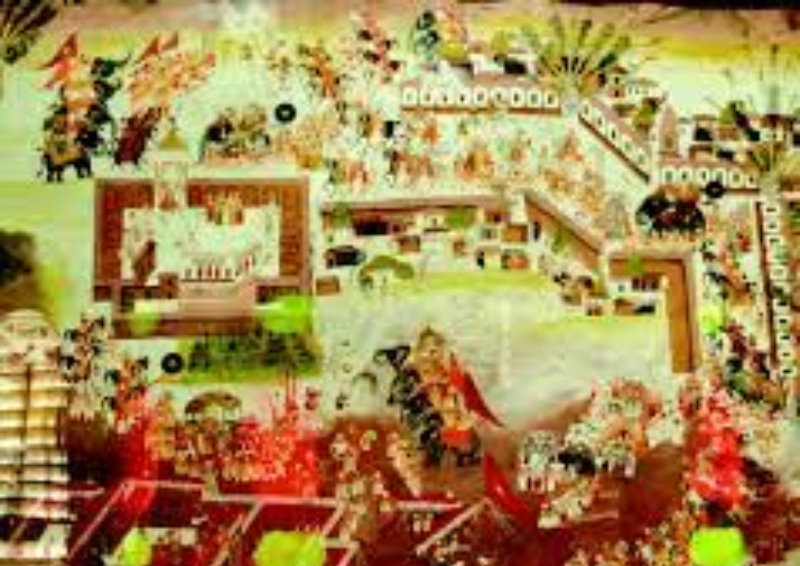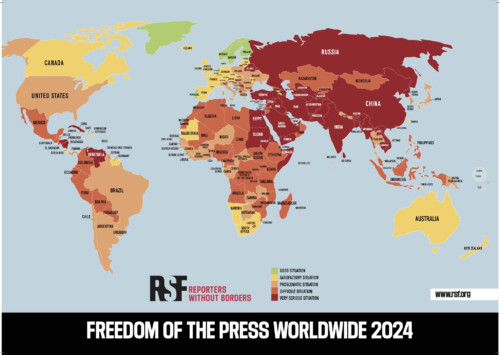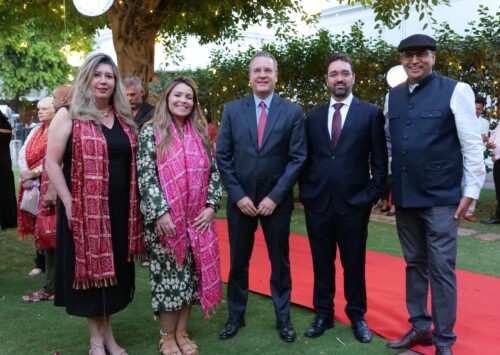Rajasthani miniature paintings: Amalgamation of history, culture and beauty

The tradition of miniature art has now been reinvented in contemporary times (MIG photos/Priyankar Bhargava)
The king of kings riding along the dense jungle path, with his raised sword gleaming in the moonlight and bow and arrows hung from his sinewy shoulders as the horse on which his proud girth is positioned gallops towards the unknown. The dark sky glittered with stars as if alive, and the whitening foliages and shrubs in the background add a mystic beauty to the otherwise darkness of the night we all are aware of. The moon shaped as a distinct canoe bestows its blessing to the brave king, who has braved both the night and the forest to hunt another king, famously termed as king of beasts.
Every painting, whether portrayed on the walls of palaces, paper, ivory, wooden tablets, textiles and even marble, has a story to tell starting from great adventures, ideal romances, passionate bonds, myriad facial expressions to day to day conducts between royalty as well as the common man.
The surrealism and magic of miniature paintings that have enriched our history, especially that of Rajasthan and also has the potential to enrich our lives was brought to the land of India by the Mughals. The Mughals brought the art form from Persia, with trained artists from that region mentoring the many budding Indian artists who had with time evolved the art form as per their culture and tradition. Like many scenes from the Mahabharata and Ramayana have also been depicted through the medium of this art form. The story of Radha and Krishna which is best expressed in Bani Thani paintings with a unique style involving exaggerated features such as long necks, almond-shaped eyes and long fingers that convey a sense of divinity to the observer is another example that brings to light the adaptation of the Persian art form by Indian artists. The creation of the art form Bani Thani has an interesting tale behind to tell. In Kishangarh kingdom of Rajasthan, during the 18th century, the ruler of the province Raja Sawant Singh had fallen in love with a slave girl whose name was Bani Thani. He was so inspired by the bond they shared that he ordered his artists to portray them as Radha and Krishna in their miniature paintings. The depictions involved portraiture of the two lovers with different backgrounds such as garden, court, music parties, naukavihar (lovers on a boat), along with many other Indian festivals like Holi, Diwali, Durga Puja and Dussehra.
The paintings were brought to life keeping in mind the minute details, and the harmony of colours and patterns that made the paintings stand out and appear almost real. Multiple perspectives were taken into account while preparing the art that reflected both the past and the present, unlike their European counterparts. The colours were painstakingly derived from nature, and days of toil would lead to extraction of a very small amount of an exquisite colour. For example, the colour red was derived from the dried fruit of Peepal tree, orange from the flower known as Palash, and green extracted from leaves and black from stones. The colour yellow, quite interestingly, was acquired from the dried urine of a sick cow. The crystallised gold or silver colours were acquired by boiling metal with camel husk and water. It would then be rubbed on a plate or ground by hand for consecutively 2-3 days resulting in a very minuscule amount of pristine concoction.
After the processes of extraction had been completed, the colours were then mixed with water and natural gum to make them all set for application. The artist had to be extra careful and make sure that the colour is uniform because if it is even the slightest out of place the painting would get spoiled as due to its extremely small size.
In October last year, Google partnered with the National Museum in New Delhi to promote miniature paintings. Besides, these rich paintings in the contemporary times have found space in the many other art galleries and museums across the subcontinent.
Sanjeev Sonpimpare, an artist based in Mumbai, describes the conceptual intricacies involved behind miniature paintings. “When it comes to the different forms of art that includes music, performance, visual arts and even architecture, they reflect how humans have evolved over the years. So, in respect to Rajasthani miniature or even miniatures they embody a long history of tradition like the depiction of Krishna-Leela through which myriad emotions are conveyed that contribute to the generation of new ideas behind miniatures. Miniature art initially wasn’t about self-expression but, later in the modern period through individuals like Raja Ravi Varma the art form, and the tradition it upheld developed. The tradition of miniature art, which is basically painting kings, queens, gods with a touch of mythology, has now been reinvented in contemporary times. Artists today are in essence imbibing from the creations of the past and reinventing new work that talk about today’s culture and society,” Sonpimpare tells Media India Group.
Kartik Gaggar, CEO of Rajasthan Studio, a leading platform of visual art experiences based in Jaipur, says that besides Kishangarh, Jaipur and Bikaner too have a popular style of miniatures.
“Whether you have the Kishangarh art form or the Jaipur art form, there are different touchpoints in Rajasthan which have their own style like the Kishangarh style is influenced by Bani Thani, and the one in Jaipur is heavily influenced by the era of the Mughals. However, in Bikaner a lot of the element of gold was used in the miniature paintings,” says Gaggar.
However, Gaggar says that the fine art, though still popular with buyers, is not attracting the right kind of talent in terms of younger artists seeking to master this technique and says there is a near total lack of originality in the contemporary times.
“The beauty of miniature painting if you see closely is because of its intricacies but, unfortunately in contemporary times over the last 30-40 years almost 50-70 pc of artists have only been copying the original work which in a sense has brought the art to a saturation level,” Gaggar tells Media India Group.
However, he remains very optimistic about the future of this delicate art form as the school that he runs continues to receive candidatures from aspiring artists from all across the country. “The passion for this art is very much alive as we receive 100-200 students every year from all across India who wish to learn and master the art,” he says.
With young blood continuously entering the domain, the Rajasthani miniature art is set to continue its larger-than life presence in the global art scene.









